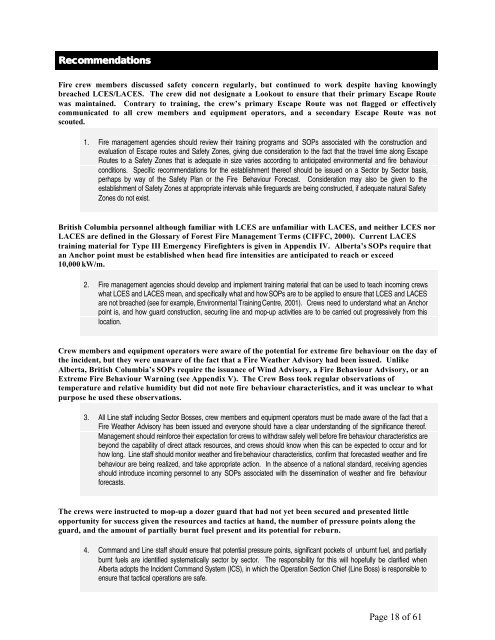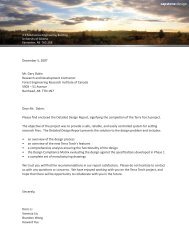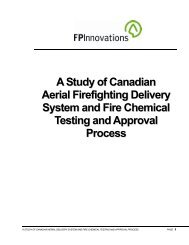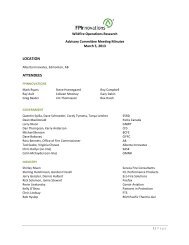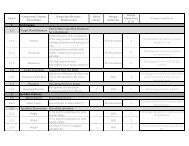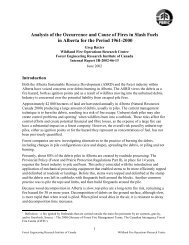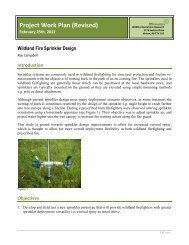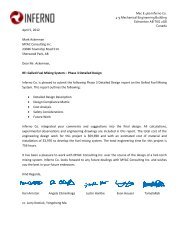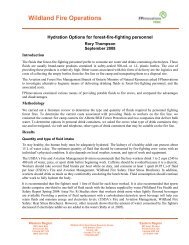Report: Chisholm wildfire entrapment investigation - FPInnovations ...
Report: Chisholm wildfire entrapment investigation - FPInnovations ...
Report: Chisholm wildfire entrapment investigation - FPInnovations ...
You also want an ePaper? Increase the reach of your titles
YUMPU automatically turns print PDFs into web optimized ePapers that Google loves.
Recommendations<br />
Fire crew members discussed safety concern regularly, but continued to work despite having knowingly<br />
breached LCES/LACES. The crew did not designate a Lookout to ensure that their primary Escape Route<br />
was maintained. Contrary to training, the crew’s primary Escape Route was not flagged or effectively<br />
communicated to all crew members and equipment operators, and a secondary Escape Route was not<br />
scouted.<br />
1. Fire management agencies should review their training programs and SOPs associated with the construction and<br />
evaluation of Escape routes and Safety Zones, giving due consideration to the fact that the travel time along Escape<br />
Routes to a Safety Zones that is adequate in size varies according to anticipated environmental and fire behaviour<br />
conditions. Specific recommendations for the establishment thereof should be issued on a Sector by Sector basis,<br />
perhaps by way of the Safety Plan or the Fire Behaviour Forecast. Consideration may also be given to the<br />
establishment of Safety Zones at appropriate intervals while fireguards are being constructed, if adequate natural Safety<br />
Zones do not exist.<br />
British Columbia personnel although familiar with LCES are unfamiliar with LACES, and neither LCES nor<br />
LACES are defined in the Glossary of Forest Fire Management Terms (CIFFC, 2000). Current LACES<br />
training material for Type III Emergency Firefighters is given in Appendix IV. Alberta’s SOPs require that<br />
an Anchor point must be established when head fire intensities are anticipated to reach or exceed<br />
10,000 kW/m.<br />
2. Fire management agencies should develop and implement training material that can be used to teach incoming crews<br />
what LCES and LACES mean, and specifically what and how SOPs are to be applied to ensure that LCES and LACES<br />
are not breached (see for example, Environmental Training Centre, 2001). Crews need to understand what an Anchor<br />
point is, and how guard construction, securing line and mop-up activities are to be carried out progressively from this<br />
location.<br />
Crew members and equipment operators were aware of the potential for extreme fire behaviour on the day of<br />
the incident, but they were unaware of the fact that a Fire Weather Advisory had been issued. Unlike<br />
Alberta, British Columbia’s SOPs require the issuance of Wind Advisory, a Fire Behaviour Advisory, or an<br />
Extreme Fire Behaviour Warning (see Appendix V). The Crew Boss took regular observations of<br />
temperature and relative humidity but did not note fire behaviour characteristics, and it was unclear to what<br />
purpose he used these observations.<br />
3. All Line staff including Sector Bosses, crew members and equipment operators must be made aware of the fact that a<br />
Fire Weather Advisory has been issued and everyone should have a clear understanding of the significance thereof.<br />
Management should reinforce their expectation for crews to withdraw safely well before fire behaviour characteristics are<br />
beyond the capability of direct attack resources, and crews should know when this can be expected to occur and for<br />
how long. Line staff should monitor weather and fire behaviour characteristics, confirm that forecasted weather and fire<br />
behaviour are being realized, and take appropriate action. In the absence of a national standard, receiving agencies<br />
should introduce incoming personnel to any SOPs associated with the dissemination of weather and fire behaviour<br />
forecasts.<br />
The crews were instructed to mop-up a dozer guard that had not yet been secured and presented little<br />
opportunity for success given the resources and tactics at hand, the number of pressure points along the<br />
guard, and the amount of partially burnt fuel present and its potential for reburn.<br />
4. Command and Line staff should ensure that potential pressure points, significant pockets of unburnt fuel, and partially<br />
burnt fuels are identified systematically sector by sector. The responsibility for this will hopefully be clarified when<br />
Alberta adopts the Incident Command System (ICS), in which the Operation Section Chief (Line Boss) is responsible to<br />
ensure that tactical operations are safe.<br />
Page 18 of 61


